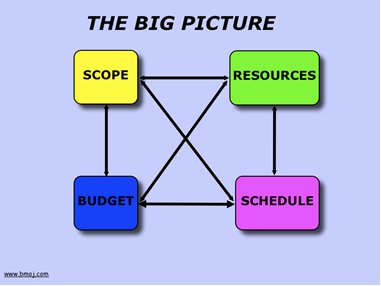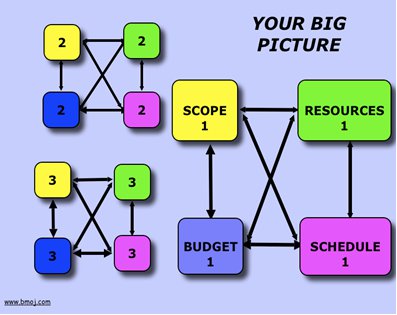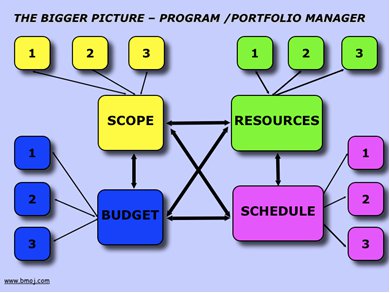
by Morley Selver, P.Eng., IPMA-B
HHas This Ever Happened To You? Have you ever go to a scope review meeting with the client where they keep adding items to the scope without any thought as to what the affect will be? After the scope changes are added up they can’t understand why their project is now way over budget. This is the sticker shock phase and results in scope cuts to get the project back to where it should be. This has happened to all project managers and will continue into the future. So don’t feel bad if it has happened to you. What you need to understand is what is happening and point out to the client that every change they make affects the project either in cost, schedule or resources required. There is no getting away from it.
You have to understand the relationship between Scope, Schedule, Budget (cost), and Resources (see Figure 1). Resources refers to people, funding, equipment, or materials. When one of these parameters changes, one or more of the other three has to change as well. In other words, as the scope is increased, the budget, schedule or resources required to meet the new scope may change. As a simple example, if you take a piping run and add a valve, the scope changes (added the valve) the budget changes (the cost of the valve), the schedule could change (the valve addition could put the piping run on the critical path) and the resources could be affected (need to redesign the pipe run with the new valve in place).

These four constraints apply to all projects and are in affect all the time. When you start your project, management has to decide whether the project will be cost driven or schedule driven. They can not have both, no matter how hard management wish and hope. You are going to manage a schedule driven project differently than one that is cost driven
You will have a disaster in the making if you, or management, change priorities in midstream, say from a schedule driven project to a cost driven project. Been there, had that done to me. When you are schedule driven, you spend the money required to meet the end dates. This could include overtime and paying to expedite material. To change from this mode to one of “we now have to watch the dollars” is difficult to do. Management has to pick the priority at the beginning and stick with it.
Recently a lot of projects were resource driven, i.e. there were not enough people to do the work, which had a big effect as it controlled the schedule. The lack of resources required the scope to be cut back to do what the resources could handle. Currently we are dealing with funding (resource) issues. The scope, schedules, and resources are being adjusted to match the funding available.

When managing your projects you have to keep this relationship in mind and you have to apply it on a daily basis. If you are managing several projects, each project has it’s own Scope, Schedule, Budget, and Resource issues that you have to contend with, (see Figure 2). The 1, 2, 3 would be your different projects.
This relationship also works in your everyday life, think of building a deck on your house and doing all the work yourself. You develop a budget, look at the scope to see what you can afford and cut scope as necessary. Since you are the only resource, your availability will determine the schedule. If you have a day job this becomes weekend or after hours work. You need vacation and some times you just don’t feel like doing anything. We’ve all been there.
But it is not just you that has this relationship, your boss has it as well, only on a higher level. Figure 3 is the arrangement you boss is looking at. The 1, 2, & 3 could represent project managers. Whereas you could be managing a $1,000,000 project, your boss is looking after the total capital budget for your company which could be in the 100’s of million dollars. For those Budget dollars, there is a corresponding Scope, Schedule, and Resources. He has the same restrictions as you do only on a larger scale. If one of the project managers overruns his budget, then the boss has to figure out where to get the additional funds from the fixed pot of capital money. He can cut scope on another project and take those funds to fund the overrun. These are everyday project decisions that have to be made.

If you work for a company that has more than one facility or division in your country, then there is probably a vice president of capital projects who has the same restrictions as you have only on a much larger scale. The 1, 2, & 3 could represent different facilities within the company. At this high a level the resources could become the funding available to the company.
If you work for a global company the 1, 2, & 3 could be different countries. Then the company would have a vice president of world projects who would have the same restrictions as you. Look at some of the global oil companies, they have capital budgets in the billions of dollars and they have to manage the money the same as you do. With the oil spill in the Gulf of Mexico, BP has to find funding (resources) to pay for the cleanup. It is known that they have gone to various banks for loans as well as the sovereign funds in the Middle East.. We don’t know if that will be enough to cover the costs or will they have to find funding within the company. The oil spill cleanup and trying to stop the flow is making the exercise schedule driven so cost is not a burning issue at this point. Once they get the flow stopped or under control, the project will either stay schedule driven or become resource driven due to availability of funding.
This relationship is the reason your project could suddenly get cancelled. If something happens in one of the facilities that requires an unexpected expenditure, rather than going on the market for more money, management will just start canceling projects until they have enough money. You could be minding your own business, have a great project, managing it perfectly, but have a border line rate of return or a lower priority, when all of a sudden it’s canceled. This is the relationship that management are following when making these type of funding decisions.
Keep this relationship in mind as it is a basic project control relationship. Make a copy and put it on your wall. Every time someone asks for something take a look at the relationship, determine what is going to change, make a note for future reference or write out a change notice accordingly.